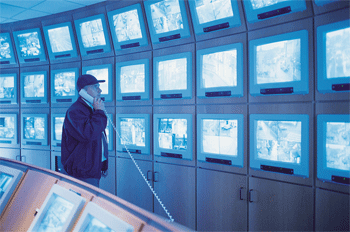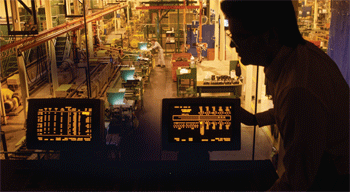Criteria for choosing a display for an industrial application differ significantly from those used in selecting a home TV screen
BY CATHY DOTSON
NEC Electronics America
Santa Clara, CA
http://www.am.necel.com/
With the number of LCD products available today, not all can be created equal nor can they be applied to just any application area. To provide the best match of LCD and application, it is important to understand the specific target market and its unique or special design issues. For instance, many displays are designed and manufactured for consumer applications, including notebook computers, tablet computers, and low-end desktop monitor applications.
However, due to very competitive pricing and time-to-market points, these modules do not always incorporate the durability, reliability, and advanced features required to survive in an industrial environment. Product life cycles are also typically much shorter in consumer applications. Therefore displays designed and manufactured for these applications are generally only available for one to two years.
Over the past few years, LCDs have been replacing CRTs as the display of choice in industrial applications, including targets such as factory automation systems and test and measurement equipment. Compared to CRT displays, the LCD format provides several advantages for the industrial market, particularly with respect to the key selection criteria of space, readability, and durability.
Space constraints
Space, or lack thereof, is a significant consideration for designers working in the industrial market. LCDs provide advantages in this area, as they offer much greater flexibility than CRTs and can achieve thinner form factors, which makes them easier to position on industrial equipment. CRT enclosures, on the other hand, require a lot of real estate for appropriate placement on a factory floor. In addition, LCDs provide greater portability in equipment design, thereby affording greater flexibility in how and where a costly piece of equipment can be used.
Readability
Display readability is another area where LCDs shine. It is important that displays used in industrial applications support clear and precise viewing from multiple angles under a variety of ambient light conditions. Most industrial environments have a high level of ambient light, which can pose challenges for display readability.
The brighter the environment, the more difficult it can be for someone to read a standard transmissive LCD with a typical brightness of 250 to 300 cd/m2 . Some LCD manufacturers have developed displays that can perform in the 450-cd/m2- and-higher range. However, these displays consume more power in some instances and may not be the best solution. Also, this brightness level is typically not adequate for very bright ambient environments.
One way to improve display readability in high-ambient-light environments without increasing power consumption is to increase the display’s contrast ratio. Typical contrast ratios for nonindustrial displays are in the range of 200:1 to 300:1, which may not be sufficient when a machine operator is viewing the display from a distance. Displays with contrast ratios around 450:1 or greater are better suited for industrial environments. The higher contrast allows a person viewing the display close by or from a distance to better differentiate the light and dark images.
Transflective technologies offer additional benefits in environments with variable ambient light. A transflective display has both transmissive and reflective characteristics. As such, it can be viewed in a dark environment using its backlight. The display also offers reflective properties that allow it to have excellent readability in environments with high ambient light.
Viewing angle
Multiangle readability is another selection factor. In a typical industrial environment, a machine operator is more likely to be positioned at an off angle rather than right in front of the display (see Fig. 1 ).

Fig. 1. In factory environments, operators must often view displays from a severe angle instead of head on.
Therefore it is important that the image be viewable from a variety of angles (right, left, up above, down below) with little or no image distortion or color shift. Implementing a display designed for consumer applications typically does not work well, as the image may wash out, or become unreadable when viewed off angle.
A number of technologies have been employed to improve off-angle LCD viewing. Some film-based technologies yield viewing angles of 80º up, 60º down, 80º right, and 80º left. These angles are sufficient for many applications, but certain others may need even greater viewing angles.
In-plane switching technology (IPS), multidomain vertical alignment (MVA) and super-fine thin-film transistor (SFT) technologies offer alternatives that are supported by a variety of LCD manufacturers. These proprietary technologies are able to achieve greater viewing angles than film-based technologies.
For instance, NEC LCD Technologies’ SFT technology achieves viewing angles of 85º up, 85º down, 85º left, and 85º right, allowing a machine operator to view the LCD from almost any angle without significant image distortion or color shift.
Size and resolution
Size and resolution also play a role in overall readability. In general, 6.5-, 8.4-, 10.4-, 12.1-, and 15-in. LCD modules are used most often in industrial applications. These sizes provide sufficient area to view data and waveforms or other graphical data without taking up too much real estate on a piece of equipment.
The resolution needed typically depends on the type of information or data being displayed. In the past, VGA, SVGA, and even XGA resolutions have been the most popular.
However, more equipment manufacturers are looking at the benefits of using displays with wider aspect ratios, such as WVGA and WXGA. The wide-aspect format enables users to view longer waveforms and more data on a single display (see Fig. 2 ). These displays can also be designed to incorporate touch-key functions on the display face, allowing users to alternate between viewing data on the wide-aspect display and combining touchscreen capability with a standard aspect ratio display. The enhanced functionality can be extremely helpful in terms of simplifying the user interface.

Fig. 2. Use of displays with wider aspect ratios allows operators to view more interrelated factory data simultaneously.
Durability/reliability
The ability to withstand temperature variations as well as shock and vibration is a key consideration when selecting displays for today’s industrial applications. The display must be resilient enough to withstand getting bumped or jiggled by machine operators or surrounding equipment, and also must be able to handle various operating temperatures. LCDs withstand temperature, shock, and vibration better than CRTs.
Storage and operating temperatures are key variables to consider when selecting a display for industrial equipment. Typically, displays are housed in an enclosure and are part of a larger piece of equipment. In these situations, temperature is affected by the enclosure and by the heat generated by the surrounding equipment.
Therefore it is important to keep the real storage and operating temperatures requirements in mind when choosing a display. While measures can be taken to dissipate the generated heat, such as using fans within the enclosure, the most efficient way to ensure compliance with storage and operating temperature requirements is to select a display that is optimized for these types of environments. Improvements in liquid-crystal materials have also made it possible to extend the optimal temperature ranges of LCDs. At the present time, many LCDs achieve temperature ranges of –10 to 70ºC.
Availability
Other, less tangible, features need to be considered when selecting a display for use in a manufacturing environment. For example, minimization of down time is critical. To achieve maximum usage, it is important that displays be of the highest quality possible and be able to be repaired on the spot with readily available spare parts rather than sent outside for repair.
Displays for industrial applications also require long product life cycles. When a module is discontinued by the manufacturer, the new display should be backward-compatible so as to fit into the existing enclosure without requiring a redesign of the entire system.
Traditionally CRTs have been attractive for industrial display applications because of their long product life and ready availability. However, CRT technology has been relatively stagnant in recent years, with few new products introduced to the market. On the other hand, LCD technology continues to evolve and offer new advanced feature sets. As these modules begin to match and potentially exceed the product life time and availability formerly available only with CRTs, we will see a significant shift toward a predominantly LCD-centric industrial market. ■
For more on displays, visit http://electronicproducts-com-develop.go-vip.net/opto.asp.
Advertisement
Learn more about NEC Electronics America





